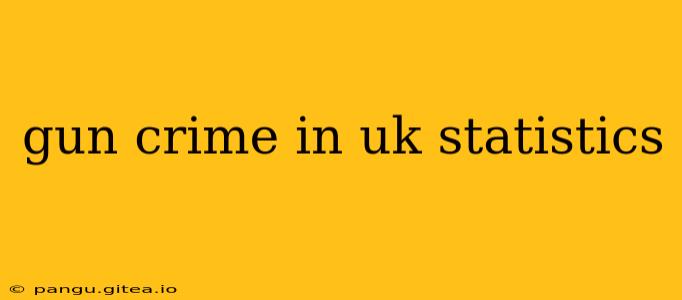Gun crime in the UK remains a significant concern, demanding careful analysis of trends and patterns to inform effective crime prevention strategies. While firearm-related incidents are considerably lower than in many other countries, understanding the statistics is crucial for policymakers, law enforcement, and the public. This article provides an overview of key statistics surrounding gun crime in the UK, exploring the types of firearms involved, regional variations, and potential contributing factors. It's important to note that data collection methods and reporting practices can evolve, so consulting the latest official sources for the most up-to-date information is always recommended.
Key Statistics on Gun Crime in the UK
Precise figures fluctuate year to year, but general trends can be observed. Data from the Office for National Statistics (ONS) and the Home Office are vital resources for understanding the scope of gun crime. While specific numbers change, the overall picture usually shows:
-
Relatively low rates compared to other developed nations: The UK consistently maintains a lower rate of gun violence than many comparable countries. This is often attributed to strict gun control legislation.
-
Firearm offences encompass a range of crimes: These include homicides, robberies, assaults, and possession of illegal firearms. The severity of these offences varies widely.
-
A shift in the types of firearms involved: While the overall numbers are low, there might be changes in the types of firearms used in crimes, reflecting shifts in the illegal arms market. This requires ongoing monitoring.
-
Regional variations: Gun crime statistics often demonstrate geographic disparities, with certain areas experiencing higher rates than others. Understanding these variations is crucial for targeted interventions.
Types of Firearms Involved
The types of firearms involved in gun crime are important to consider. The statistics often categorize these into:
- Handguns: These remain a significant concern, though their prevalence may vary over time.
- Shotguns: These may be involved in both violent crimes and other offenses.
- Long guns (rifles): These are less frequently involved in gun crime compared to handguns.
- Improvised firearms: These homemade or modified weapons present a unique challenge for law enforcement.
Contributing Factors & Challenges
Understanding the complexities of gun crime requires examining potential contributing factors, including:
- Illegal firearms trafficking: The flow of illegal weapons into the UK significantly impacts crime rates.
- Gang violence: Firearms are often involved in gang-related activities and disputes.
- Mental health issues: While not the sole cause, mental health concerns can sometimes be a factor in gun-related incidents.
- Socioeconomic factors: Poverty, deprivation, and lack of opportunity may contribute to increased crime rates in certain areas.
The Importance of Data Analysis and Prevention
The ongoing collection and analysis of gun crime statistics are crucial for effective crime prevention strategies. This data informs:
- Targeted policing: Law enforcement can allocate resources to areas with higher rates of gun crime.
- Legislative changes: Policymakers can use data to evaluate the effectiveness of existing gun control laws and inform potential reforms.
- Community initiatives: Data can help target resources towards community-based crime prevention programs.
By continuously monitoring and analyzing gun crime statistics, the UK can strive to maintain its relatively low rates of gun violence and address the underlying issues contributing to these crimes. Remember to refer to the latest official publications for the most current and accurate information.
